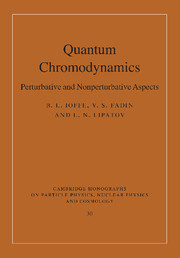Book contents
- Frontmatter
- Contents
- Preface
- 1 General properties of QCD
- 2 Chiral symmetry and its spontaneous violation
- 3 Anomalies
- 4 Instantons and topological quantum numbers
- 5 Divergence of perturbation series
- 6 QCD sum rules
- 7 Evolution equations
- 8 QCD jets
- 9 BFKL approach
- 10 Further developments in high-energy QCD
- Notations
- Index
2 - Chiral symmetry and its spontaneous violation
Published online by Cambridge University Press: 20 May 2010
- Frontmatter
- Contents
- Preface
- 1 General properties of QCD
- 2 Chiral symmetry and its spontaneous violation
- 3 Anomalies
- 4 Instantons and topological quantum numbers
- 5 Divergence of perturbation series
- 6 QCD sum rules
- 7 Evolution equations
- 8 QCD jets
- 9 BFKL approach
- 10 Further developments in high-energy QCD
- Notations
- Index
Summary
The general properties of QCD at low energies
The asymptotic freedom of QCD, i.e. the logarithmic decrease of the QCD coupling constantat large momentum transfers Q2 → ∞ (or, equivalently, the decrease of αs at small distances, αs (r) ∼ 1/ ln r) allows one to perform reliable theoretical calculations of hard processes, using perturbation theory. However, the same property of the theory implies an increase of the running coupling constant in QCD at small momentum transfer, i.e. at large distances. Furthermore, this increase is unlimited within the framework of perturbation theory. Physically such growth is natural and is even needed, because otherwise the theory would not be a theory of strong interactions.
QCD possesses two remarkable properties. The first is the property of confinement: quarks and gluons cannot leave the region of their strong interaction and cannot be observed as real physical objects. Physical objects, observed experimentally at large distances, are hadrons – mesons and baryons. The second important property of QCD is the spontaneous violation of chiral symmetry. The masses of light u, d, s quarks that enter the QCD Lagrangian, especially the masses of u and d quarks from which the usual (nonstrange) hadrons are built, are very small as compared to the characteristic QCD mass scale. In QCD, the quark interaction is due to the exchange of vector gluonic field. Thus, if light quark masses are neglected, the QCD Lagrangian (its light quark part) becomes chirally symmetric, i.e. not only vector, but also axial currents are conserved.
- Type
- Chapter
- Information
- Quantum ChromodynamicsPerturbative and Nonperturbative Aspects, pp. 53 - 81Publisher: Cambridge University PressPrint publication year: 2010



